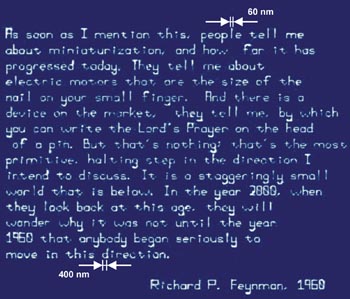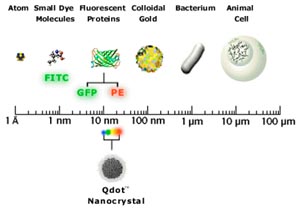Home > Introduction > Nanotechnology Basics
Nanotechnology Basics
Last Updated: Monday, 20-Apr-2015 19:51:36 PDT
What is Nanotechnology? Answers differ depending on who you ask, and their background. Broadly speaking however, nanotechnology is the act of purposefully manipulating matter at the atomic scale, otherwise known as the "nanoscale."
Coined as "nano-technology" in a 1974 paper by Norio Taniguchi at the University of Tokyo, and encompassing a multitude of rapidly emerging technologies, based upon the scaling down of existing technologies to the next level of precision and miniaturization. Taniguchi approached nanotechnology from the 'top-down' standpoint, from the viewpoint of a precision engineer.
Foresight Nanotech Institute Founder K. Eric Drexler introduced the term "nanotechnology" to the world in 1986, using it to describe a 'bottom-up' approach. Drexler approaches nanotechnology from the point-of-view of a physicist, and defines the term as "large-scale mechanosynthesis based on positional control of chemically reactive molecules." See our Press Kit History of Nanotechnology for details.
In the future, "nanotechnology" will likely include building machines and mechanisms with nanoscale dimensions, referred to these days as Molecular Nanotechnology (MNT).

Click image for larger version.
From "There's Plenty of Room at the Bottom" December 29th, 1959
This image was written using Dip-Pen Nanolithography, and imaged using lateral force microscopy mode of an atomic force microscope. Courtesy the Mirkin Group, Northwestern University.
It uses a basic unit of measure called a "nanometer" (abbreviated nm). Derived from the Greek word for midget, "nano" is a metric prefix and indicates a billionth part (10-9).
There are one billion nm's to a meter. Each nm is only three to five atoms wide. They're small. Really small. ~40,000 times smaller than the width of an average human hair. (See How small is one-billionth of a meter?)
A good reference to visit to help you understand the nanoscale materials end of "nanotech" is the Teacher's Guide To The (Small) World Of Nanostructured Materials
One aspect of nanotechnology is all about building working mechanisms using components with nanoscale dimensions (MNT), such as super small computers (think bacteria-sized) with today's MIPS capacity, or supercomputers the size of a sugar cube, possessing the power of a billion laptops, or a regular sized desktop model with the power of trillions of today's PC's.
The other aspect deals with scaling down existing technologies to the nanoscale, examples of which can be seen at our Current Uses page.
Some of the most promising potential of nanotechnology exists due to the laws of quantum physics. Quantum physics laws take over at this scale, enabling novel applications in optics, electronics, magnetic storage, computing, catalysts, and other areas.
Regardless of the diverse opinions on the rate at which nanotechnology will be implemented, people who make it a habit of keeping up with technology advances agree on this: it is a technology in its infancy, and it holds the potential to change everything.
Read this great Introduction from the Center for Responsible Nanotechnology for a better understanding of what nanotechnology is and is not, the social and business implications, and some steps being considered to control misuse.
Related and interwoven fields include, but are not limited to: Nanomaterials, Nanomedicine, Nanobiotechnology, Nanolithography, Nanoelectronics, Nanomagnetics, Nanorobots, Biodevices (biomolecular machinery), AI, MEMS (MicroElectroMechanical Systems), NEMS (NanoElectroMechanical Systems), Biomimetic Materials, Microencapsulation, and many others.
SIZE
Let's start BIG, with something you can get your hands on (so to speak):
A meter is about the distance from the tip of your nose to the end of your hand (1 meter = 3.28 feet).
One thousandth of that is a millimeter.
Now take one thousandth of that, and you have a micron: a thousandth of a thousandth of a meter. Put another way: a micron is a millionth of a meter, which is the scale that is relevant to - for instance - building computers, computer memory, and logic devices.
Now, let's go smaller, to the nanometer:
A nanometer is one thousandth of a micron, and a thousandth of a millionth of a meter (a billionth of a meter). Imagine: one billion nanometers in a meter.
Another perspective: a nanometer is about the width of six bonded carbon atoms, and approximately 40,000 are needed to equal the width of an average human hair.
Another way to visualize a nanometer:
1 inch = 25,400,000 nanometers
Red blood cells are ~7,000 nm in diameter, and ~2000 nm in height
White blood cells are ~10,000 nm in diameter
A virus is ~100 nm
A hydrogen atom is .1 nm
Nanoparticles range from 1 to 100 nm
Fullerenes (C60 / Buckyballs) are 1 nm
Quantum Dots (of CdSe) are 8 nm
Dendrimers are ~10 nm
DNA (width) is 2 nm
Proteins range from 5 to 50 nm
Viruses range from 75 to 100 nm
Bacteria range from 1,000 to 10,000 nm
For our purposes, nanometers pertain to science, technology, manufacturing, chemistry, health sciences, materials science, space programs, and engineering.
|
Nanotechnology is the understanding and control of matter at dimensions of roughly 1 to 100 nanometers, where unique phenomena enable novel applications. Encompassing nanoscale science, engineering and technology, nanotechnology involves imaging, measuring, modeling, and manipulating matter at this length scale.
At the nanoscale, the physical, chemical, and biological properties of materials differ in fundamental and valuable ways from the properties of individual atoms and molecules or bulk matter. Nanotechnology R&D is directed toward understanding and creating improved materials, devices, and systems that exploit these new properties. From What is Nanotechnology? |
|
Powers of 10 From 10-15 meters (a fermi), in steps of 10, to 10 -9 meters (nanometer), all the way out to 10 +16 meters (a lightyear), and finally, to 10 +23 meters (10 million light years). If you have not seen this really neat series of viewpoints, it can help to put scale into perspective!
|
![]() The laws list a list of various laws, rules, principles, and other related topics in physics and astronomy.
The laws list a list of various laws, rules, principles, and other related topics in physics and astronomy.
"We know it's possible. We know it's valuable. We should do it."
—Ralph Merkle - Xerox PARC and Senior Research Associate, IMM
|
|
||
|
|
||
| The latest news from around the world, FREE | ||
|
|
||
|
|
||
| Premium Products | ||
|
|
||
|
Only the news you want to read!
Learn More |
||
|
|
||
|
Full-service, expert consulting
Learn More |
||
|
|
||
